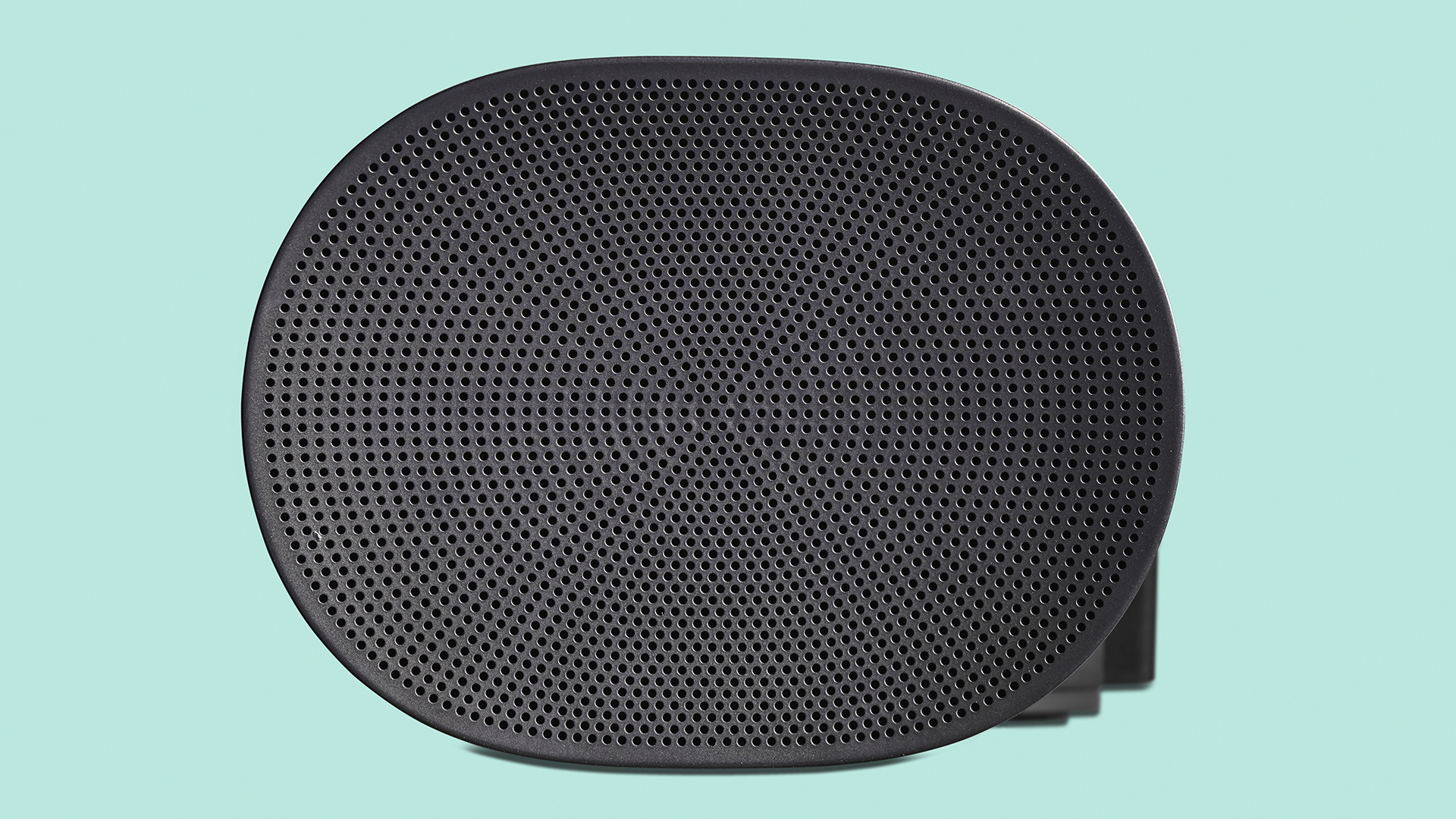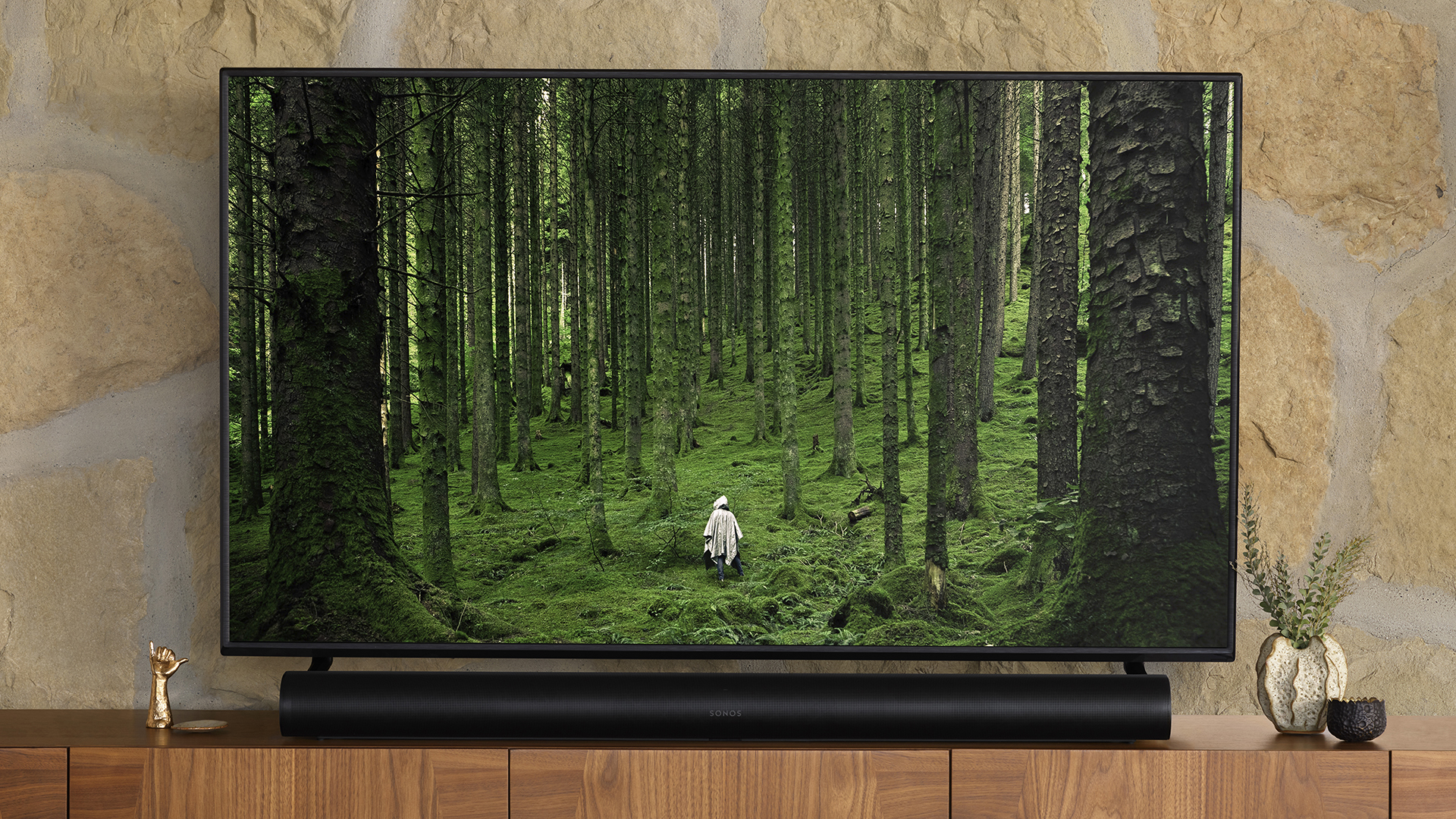Sonos Arc review: a rich, rewarding Dolby Atmos soundbar
The Sonos Arc adds huge width and height to your movies, with an impeccable sound balance… but a few small frustrations, too

The Sonos Arc delivers five-star spatial sound, but it's not replacement for a true Dolby Atmos surround system on its own, and there are some lacking features
-
+
Fantastic tall, wide Dolby Atmos audio
-
+
Excellent with music too
-
+
Great streaming and smart features
-
-
Just one HDMI port
-
-
Can't match a full surround Atmos system
-
-
Adding a sub is so expensive
Why you can trust T3

Welcome to T3's Sonos Arc review! This is Sonos' first foray into the world of Dolby Atmos soundbars and 3D audio. Sonos has been making home cinema products from seven years now, since the PlayBar, and took a big step into the waters of surround sound with the ability to combine satellite speakers with the soundbar for a 5.1 system. But home cinema technology moved on, Dolby Atmos arrived, and 3D audio with height became the big new thing.
Really, the only flaw in the fantastic Sonos Beam was a lack of Dolby Atmos height support, and actually we didn’t mind that because it was an excellent price, and real Atmos capability in speakers that size and price range is very limited. It's been riding high in our list of the best soundbars since its release, and is the best soundbar for under £350.
But there was still an Atmos-sized gap in Sonos’ range, and that’s where the Arc swoops in, bringing a bigger, beefier soundstage in every way, including upfiring drivers for adding height to proceedings, as well as more effort to produce spatial surround-like sound from the single bar, as is all the rage these days.
It’s a much bigger, beefier bar to match the sound upgrades: where as the Sonos Beam is petite enough to pair with sets as small as the best 32-inch TVs or best 43-inch TVs, this is around the same width as the best 55-inch TVs, so you'll want to pair it with that size and up – it's also a great option as one of the best soundbars for Samsung TVs.

Sonos Arc review: price, release date & features
Released in June 2020 at £799/$799/AU$1,399, the Arc comes in at a pretty typical price for Atmos soundbars. It’s common for them to break into four figures (especially if they include rear speakers and/or a subwoofer), though more budget options are available too, such as the Sharp HT-SBW800.
The budget models won’t have the fit and finish of the Arc, of course… nor its remarkable prowess with sound, but we don’t want to get ahead of ourselves there.
The Arc features 11 speaker drivers, with individual amplification for each, naturally. These include two angled upwards to reflect sound off the ceiling and create the height channel promised by Dolby Atmos, plus two facing out on the left and right for extreme width, plus another two at a less extreme left and right angle. And some face actually towards you too, of course.
The Arc doesn’t come with a subwoofer, though a new version of Sonos’ Sub is available for £699/$699/AU$999, which is… quite a lot. The Sub uses pretty high-end techniques such as force-opposing twin drivers (so the unit itself doesn’t shake when the speakers are really rumbling), but given that a lot of Sonos’ gear is generally mainstream-friendly pricing, these days, the Sub is an outlier.
Our biggest gripe with the Sonos Arc overall is HDMI connectivity: it features a single eARC HDMI connection, which is the way you should be connecting it. It has optical too, but that’s more limiting for soundtrack type support, and doesn’t enable instant control of the unit from your TV’s remote.
Sonos really cheaped out by having a single HDMI port, though – similar bars tend to have two-to-four HDMI inputs as well as the output to the TV. This isn't just a spec-swinging show-off element, though: having just one HDMI limits which TVs the bar can reach its full potential on, and can just be downright inconvenient.
In the latter case, it means losing an HDMI port on your TV simply to connect the bar, and you might not have that port spare. There are TVs on-sale both recently and today that only have two or three 4K-ready HDMI ports, where one of those is the ARC port you'd have to connect to. If the Sonos had even a single HDMI passthrough, you could plug it in without losing use of that port for your PS4 Pro or whatever… but it doesn't.
Secondly, if your TV doesn’t decode or passthrough Dolby Atmos properly, Atmos soundtracks won’t reach the soundbar at their full quality – if the Arc had HDMI inputs, you could plug Atmos-enabled gear directly into it, so the Atmos sound signals get used properly by the soundbar the before they even hit the TV. If you have a slightly older set, this would've been ideal, but no. If this is a problem for you, we'll pick out some alternative soundbars in the 'Verdict' section further down.
We also don’t like that there’s no volume indicator on the Arc, since some TVs won’t show a volume level on-screen if you have an external receiver connected. The Arc is actually really good at levelling out sources that push in audio at wildly differing levels, so you don't get that thing of Netflix playing really quietly but YouTube shaking the walls down at the same volume, but you still have no idea how loud things will be when you turn your TV on.
There’s no remote – you’ll need to use the app or voice assistant control to adjust settings and modes, which can be a little annoying, but not a big problem. You can tweak things like bass levels in the app, and there's a Night Mode setting for limiting its dynamic oomph if people are asleep upstairs.
Those few paragraphs are our only real complaints about the Arc. Amazon Alexa and Google Assistant voice control are on board here for that voice control we just mentioned – useful for making this your sole living-room speaker while still keeping smart functionality.
It's also equipped with Apple AirPlay 2 multi-room streaming, as well as Sonos' own app-based streaming and multi-room capabilities. You can connect it over Wi-Fi or ethernet. There's no Bluetooth, though.

Sonos Arc review: sound quality
Let’s kick this section off with the promise of getting something akin to surround sound from a single bar: this is usually an overblown claim (the Sennheiser Ambeo is the best at it, and it costs over twice as much as the Arc…), and sure enough the Arc can’t really achieve it either.
But that's okay: neither can the B&O Beosound Stage, and that just won our Best Soundbar gong at the T3 Awards 2020, and costs hundreds more than the Arc. We don't consider this a problem at all – it's just something to know.
What you get from the Arc is more like a wall of sound, and that in itself massively impresses us. The noise it creates doesn’t appear to come from the bar; it fills the space in front of you, up to the ceiling, from wall to wall.
If you’ve spent a lot of money on one of the best TVs, this is an ideal accompaniment, because it feels like the sound is as expressive as your screen, occupying that same space, so the sound and visuals feel truly connected.
That ability is obvious from the moment you turn it on – whatever you watch (Atmos or not) gets this extra scale of presentation.
Obviously, we still went straight to some Atmos content for getting the full effect. As we say, if you’re hoping for the cinema-like Atmos surround experience, you’re going to be a bit disappointed here – when it comes to height, it doesn’t quite give you the feeling of things bursting directly overhead, or of something being truly behind you (though you can, as before, add more Sonos speakers to act as rear surround speakers – buying a pair of Sonos One SL units along with the Arc is actually a pretty competitive price at just over £1000/$1000/AU$1,390).
But you do absolutely still get major expressions of height and width built into that wall of sound in front of you. As is usual, you’ll notice it most from movement: something falling from the sky to earth distinctly moves down in the soundscape and strikes with impact thanks to solid on-device bass. Something screeching left to right matches the pace and dynamism on-screen.
It has the capacity to surprise with smaller spatial details too: we said it can’t surround you, but it does still add a distinct depth with the right soundtrack. In a scene of someone addressing a crowd, a primary voice comes through clear filling the front, but as someone in the back yells, that sound feels distinctly backgrounded. The Arc alone can’t make it come from behind you, but it still sounds like it comes from a different place, with a different tenor, to the first speaker, still giving the scene a kind of layered 3D richness.
It often surprised us with those types of touches even where we weren’t necessarily expecting them: in scenes of waves, watching one crest and fall filled the wall in front of us, but you could also hear the turmoil to the left and right of the screen, where the edges of the same wave had already crashed out of view of the camera, but captured by the mic.
Importantly, along with this really impressive size it also does the boring things well. Speech is emphasised out of soundtracks clearly even when the dedicated Speech Enhancement option is turned off.
There’s more than enough bass to be satisfying for action soundtracks, and it feels suitably punchy – you’re not being let down badly by the lack of separate sub. But it still can’t quite match the soft ambient rumble that a big low-end unit can provide, even when it's a cheaper model. Watching those waves we mentioned again on the Sony HT-G700 (which is aimed very much as a kind of cheaper Arc alternative) with its dedicated sub, there’s an additional menacing depth to their noise.
Like we said, we don't think the Arc is faltering without a sub, but there's definitely a case for adding one, and it’s a shame that doing so almost doubles the price.
We shouldn't forget Sonos’ other speciality: music. As you'd expect, it sounds just as excellent for that, making full use of all those speakers, plus Sonos’ knack for detailed presentation and finely honed balance.
The dynamism that serves it so well for mixing quiet and loud on a movie also works well in its favour for instruments: everything is buttery smooth, as well as big.

Sonos Arc review: design and usability
Setup is as easy as any other Sonos speaker – take it out, plug it in, follow instructions in the app, and then do some TruePlay tuning. This latter part is optional, but is recommended here, since it will help the Arc to really target it sounds as well as possible. It takes just a minute, but sadly remains a feature only available to iOS users still – we were surprised not to see the Auto TruePlay tuning of the Sonos Move here.
As we mentioned, the app includes ways to tweak modes and settings on the Arc, which are buried a couple of levels deep. Having this stuff tucked away in an app focused on music isn't ideal, but as we mentioned, they're also accessible through the smart assistants, so if you have those set up, it's simpler. And when you know where they are, it's certainly not hard to tweak them.
We don't mind not having another remote control to think about, but it's equally true that your elderly relative might have preferred one if they come to stay.
In terms of looks, it's nice, though somewhat functional. The Sonos Beam is more stylish, thanks to a fabric outside and its neat mix of a lozenge shape and concave top. The Beam is just a big cylinder, finished in solid plastic riddled with holes. It looks fine and simple, which is what we prioritise most in a soundbar – but it doesn't compete with the B&O Stage for style.
All that said, a hard plastic outside is definitely easier to dust, so we love it for that…

Sonos Arc review: Verdict
If we were judging on audio quality alone, this would be a five-star review. The sound is so engaging and dynamic, and is a huge step up over what simpler budget soundbars (or built-in TV speakers) can achieve.
We've mentioned its limitations in terms of surround-sound capabilities, but what it produces is so rich and layered, we simply don't mind at all. If our gripes don’t sound like they’d bother you, it gets a full-volume recommendation. We love the Sonos Arc, and if it ticks your boxes in technical terms, you will too.
But we're using it with a TV that gives us no problems for its single HDMI port. It might be that you don't find this to be a problem at all, in which case go forth and enjoy it. But for some, it's a full-on dealbreaker, and we're just not sure why that should be the case in a soundbar costing close to four figures.
Also consider
When it comes to competition, we've already mentioned the Sennheiser Ambeo and B&O Beosound Stage as more expensive options – both are phenomenally good single-box soundbars.
If you're looking for a soundbar with real surround effects, take a look at our LG SN11RG review, a package that comes with a bar, a subwoofer, and rear speakers with their own upfiring drivers, to deliver a more complete overhead Dolby Atmos effect. The package costs a lot more than the Sonos Arc, though. It has two HDMI inputs, too, as well as the HDMI out connection to the TV.
The Samsung HW-Q90R is also a soundbar/sub/rear speakers package with four upfiring drivers and recent price cuts have brought it down to only a little more than the Sonos Arc, and much cheaper than the LG SN11RG (though it sounds pretty much as good) – it's phenomenal value for a glorious system. However, the Arc handles music better, if that's a priority. Again, it has two HDMI inputs, plus the HDMI output.
We already mentioned the Sony HT-G700, which is a single-bar system (ie, no surrounds) with Atmos support, like the Arc, but it comes with a subwoofer (and an HDMI input). With only three drivers, it can't create a wall of sound that's as impressive as the Sonos Arc (and the overall audio quality is not as dynamically rich), but you'd be surprised at how close it is for something costing nearly half the price. If you were thinking you like the idea of the Arc but not the price, definitely read our Sony HT-G700 review.
And finally, let's not forget the Sonos Beam. If the Arc's price and audio magic sound like overkill for what you're after, this simple stereo soundbar still comes all the great streaming tricks, is a giant step up over the audio in most TVs (especially for dialogue), and is an excellent price.
Sign up to the T3 newsletter for smarter living straight to your inbox
Get all the latest news, reviews, deals and buying guides on gorgeous tech, home and active products from the T3 experts
Matt is T3's former AV and Smart Home Editor (UK), master of all things audiovisual, overseeing our TV, speakers and headphones coverage. He also covered smart home products and large appliances, as well as our toys and games articles. He's can explain both what Dolby Vision IQ is and why the Lego you're building doesn't fit together the way the instructions say, so is truly invaluable. Matt has worked for tech publications for over 10 years, in print and online, including running T3's print magazine and launching its most recent redesign. He's also contributed to a huge number of tech and gaming titles over the years. Say hello if you see him roaming the halls at CES, IFA or Toy Fair. Matt now works for our sister title TechRadar.
-
 Warning: Ciele’s refreshed Elite Collection may cause excessive garment envy on race day
Warning: Ciele’s refreshed Elite Collection may cause excessive garment envy on race dayFlex on your run crew with Ciele’s latest drop
By Matt Kollat Published
-
 Smeg adds a touch of navy sophistication to its iconic breakfast set
Smeg adds a touch of navy sophistication to its iconic breakfast setIt's a minimalist's dream
By Lizzie Wilmot Published
-
 My most anticipated Netflix movie of the year gets a wild new trailer
My most anticipated Netflix movie of the year gets a wild new trailerHavoc looks pretty unbelievable
By Max Freeman-Mills Published